
14 minute read
CLÚSTER DEL PACKAGING
El Clúster del Packaging celebra su décimo aniversario con más de 160 invitados The Packaging Cluster celebrates its tenth anniversary with more than 160 guests
Actualidad Latest news
Martina Font, presidenta del Clúster del Packaging President of the Packaging Cluster..
El Packaging Cluster celebró su décimo aniversario el 1 de diciembre en una gala que sirvió como punto de encuentro de todo el sector y que estuvo marcada por su carácter festivo. En total, acudieron más de 160 personas entre socios, periodistas e integrantes del propio Clúster.
El evento, que fue dirigido por la periodista Xantal Llavina, se organizó en el Hotel Gallery, en pleno centro de Barcelona. Se inició con una ponencia a cargo de Albert Castellanos, secretario de Empresa y Competitividad de la Generalitat de Catalunya y actual consejero delegado de ACCIÓ, que destacó «la importancia de los clústeres a la hora de generar valor compartido». Y añadió: «el Packaging Cluster es uno de los clústeres con más reputación de nuestro ecosistema industrial .../... Es una entidad joven, pero ya podemos decir que es uno de los clústeres más consolidados de Cataluña. Desde las instituciones trabajaremos para seguir arrimando el hombro para apoyar la labor tan importante que desempeñáis».
A continuación, los dos presidentes anteriores del Packaging Cluster, Núria Font y Artur Costa, y la actual presidenta, Martina Font, hicieron balance del pasado, presente y futuro de la entidad. Núria Font habló de cuatro factores decisivos para el nacimiento del Packaging Cluster en octubre de 2012: la industria gráfica, el sector textil, el desarrollo económico del Estado que llevó a nuevas necesidades de los consumidores y la consolidación de la industrai agroalimentaria como el principal sector económico en Cataluña. Artur Costa afirmó que «un clúster sirve para incrementar la competitividad de nuestras empresas» y destacó cuatro puntos: la gobernanza, los profesio-

Xantal Llavina. Albert Castellanos.

nales altamente comprometidos, una administración comprometida también con la política de los clústeres y unos socios comprometidos. Por último, Martina Font afirmó que «las previsiones siguen mostrando un crecimiento del sector del packaging« y destacó «la defensa de la industria», así como «trabajar para hacer las industrais sostenibles». «En el clúster nos gusta pensar en grande y queremos seguir creciendo. Tenemos un equipo muy joven cargado de talento e ilusión”, explicó Font. Y lanzó una petición a las instituciones: «la industria es un elemento clave para Catalunya y hay que potenciarla. El objetivo es que el peso del sector industrial sea del 30 % en 2030 y, para logarlo, necesitamos el apoyo de todos«.
La parte más formal del acto concluyó con la intervención de Àlex Brossa (Cluster Manager) y la entrega de cuatro galardones como reconocimiento a las buenas prácticas dentro del sector:
• Cambio estratégico y crecimiento: Toni Borrell,
CEO de NG Plastics. • Valor compartido y sostenibilidad: Tim Eaves,
Presidente de Quadpack. • Industria 4.0 & Innovación: Aleix Triana,
CEO de Industrias Plásticas Triana. • Reconocimiento Honorífico: Pere Castellet, ex Conseller del Packaging Cluster.
Unos premios que finalizaron con el reconocimiento a los socios fundadores del clúster en 2012, a los que Jordi Bernabeu, presidente de Hispack, y Xavier Pascual, director de Hispack, les entregaron una placa: ABB, Aranow, Grupo Carinsa, DS Smith, Enplater, Global Fruselva, Industrias Plásticas Triana, Kao Chimigraf, Centro Tecnológico Leitat, Menshen y Nestlé.
Una identidad visual renovada
El Packaging Cluster aprovechó el décimo aniversario para presentar una nueva identidad visual. El logo, que acompaña a la entidad desde su fundación en 2012, ha sido sustituido por uno con un diseño más contemporáneo en consonancia a la imagen de innovación y proximidad que quiere transmitir. Además, el isotipo en forma de cruz refleja el punto de unión y el carácter aglutinador que caracteriza la figura de un clúster.
«El nuevo logo responde a la necesidad de transmitir una imagen de modernidad y dinamismo. El sector del packaging está en pleno crecimiento y, aunque mucha gente lo desconozca, es uno de los prolíficos en términos de innovación. Este salto en nuestra identidad visual nos acercará a que esa realidad sea más fácil transmitible a la sociedad», concluyó Àlex Brossa.
El acto finalizó con una divertida actuación llena de magia y humor.
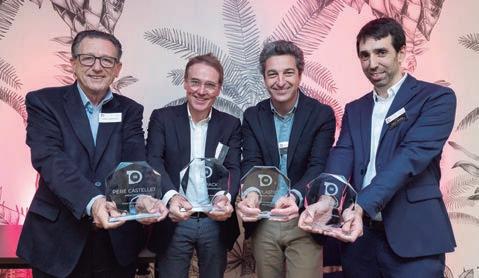
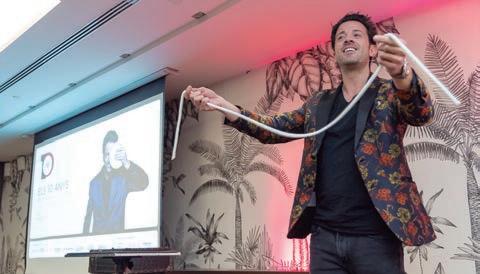

Artur Costa, Martina Font & Núria Font.
Los cuatro homenajeados con sus premios. The four honorees with their awards.

Àlex Brossa, Cluster Manager.

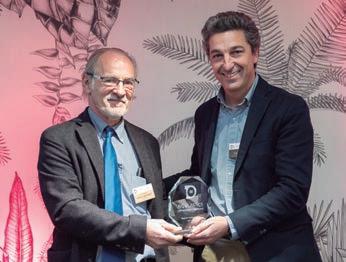
Actualidad Latest news
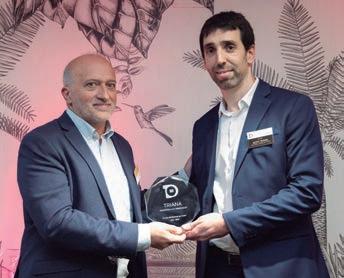
Antoni Graupera (Tai Smart Factory) & Aleix Triana (Industrias Plásticas Triana).
Sergi Escuriet (Lubrizol) & Toni Borrell (NG Plastics).
José Manuel Aguiló (Hinojosa) & Tim Eaves (Quadpack).
Pere Castellet & Albert Castellanos. Xavier Pifarré (ABB) entre between Jordi Bernabeu & Xavier Pascual.


The Packaging Cluster celebrated its tenth anniversary on December 1 at a gala that served as a meeting point for the entire sector and was marked by its festive nature. In total, more than 160 people attended, including partners, journalists and members of the Cluster itself.
The event, which was directed by the journalist Xantal Llavina, was organized at the Hotel Gallery, in the heart of Barcelona. It began with a presentation by Albert Castellanos, Secretary for Business and Competitiveness of the Generalitat de Catalunya and current CEO of ACCIÓ, who highlighted "the importance of clusters when it comes to generating shared value". And he added: «The Packaging Cluster is one of the most reputable clusters in our industrial ecosystem... /... It is a young entity, but we can already say that it is one of the most consolidated clusters in Catalonia. From the institutions we will work to continue pitching in to support the important work that you carry out.
Next, the two previous presidents of the Packaging Cluster, Núria Font and Artur Costa, and the current president, Martina Font, took stock of the past, present and future of the entity. Núria Font spoke of four decisive factors for the birth of the Packaging Cluster in October 2012: the graphic industry, the textile sector, the economic development of the State that led to new consumer needs and the consolidation of the agri-food industry as the main sector. economy in Catalonia. Artur Costa affirmed that "a cluster serves to increase the competitiveness of our companies" and highlighted four points: governance, highly committed professionals, an administration also committed to cluster policy and committed partners. Finally, Martina Font stated that "the forecasts conti-

nue to show growth in the packaging sector" and highlighted "the defense of the industry", as well as "working to make the industry sustainable". «In the cluster we like to think big and we want to continue growing. We have a very young team full of talent and enthusiasm”, explained Font. And she launched a petition to the institutions: «the industry is a key element for Catalonia and it must be promoted. The goal is for the weight of the industrial sector to be 30% in 2030 and, to achieve this, we need everyone's support".
The most formal part of the act concluded with the intervention of Àlex Brossa (Cluster Manager) and the delivery of four awards in recognition of good practices within the sector: • Strategic change and growth: Toni Borrell, CEO of NG Plastics. • Shared value and sustainability: Tim Eaves, President of Quadpack. • Industry 4.0 & Innovation: Aleix Triana, CEO of Industrias Plásticas Triana. • Honorary Recognition: Pere Castellet, former Minister of the Packaging Cluster.
Some awards that ended with the recognition of the founding members of the cluster in 2012, to which Jordi Bernabeu, President of Hispack, and Xavier Pascual, Director of Hispack, presented them with a plaque: ABB, Aranow, Grupo Carinsa, DS Smith, Enplater , Global Fruselva, Industrias Plásticas Triana, Kao Chimigraf, Leitat Technological Center, Menshen and Nestlé.
A renewed visual identity
The Packaging Cluster took advantage of the tenth anniversary to present a new visual identity. The logo, which has accompanied the entity since its foundation in 2012, has been replaced by one with a more contemporary design in line with the image of innovation and proximity that it wants to convey. In addition, the cross-shaped isotype reflects the point of union and the agglutinating character that characterizes the figure of a cluster.
«The new logo responds to the need to convey an image of modernity and dynamism. The packaging sector is in full growth and, although many people are unaware of it, it is one of the most prolific in terms of innovation. This leap in our visual identity will bring us closer to making this reality easier to transmit to society”, concluded Àlex Brossa.
The act ended with a fun performance full of magic and humor.
El equipo del Clúster del Packaging. The Packaging Cluster team.
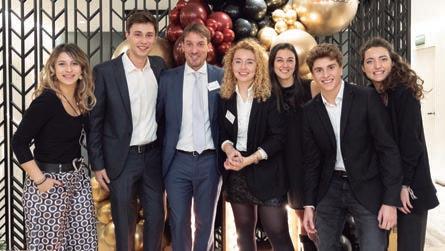
Proyectos Projects
Aprobados los cinco proyectos que el Packaging Cluster presentó en la línea de ayudas a las AEI The five projects that the Packaging Cluster presented in the line of aid to AEIs have been approved
El Ministerio de Industria, Comercio y Turismo publicó la resolución provisional de la segunda convocatoria de ayudas de 2022 en apoyo a las Agrupaciones Empresariales Innovadoras (AEI), donde el Packaging Cluster ha conseguido que se aprobasen los cinco proyectos presentados.
Entre las 5 iniciativas aprobadas, cuatro han sido lideradas por el Packaging Cluster y una por el Clúster de Materials Avançats de Cataluña. En total se han involucrado 27 agentes de diversos sectores transversales a los del packaging, con 11 empresas asociadas: TAI Smart Factory, Dribia, Gerosa Group, Iflex, Molmasa, Bertia, Industrias Plásticas Triana, Kuka, Tepsis, VM Systems y Rotimpres.
DDM (Data-Driven Maintenance): digitalización del proceso productivo para una gestión del mantenimiento basada en datos
Es la segunda parte del proyecto ATEX&QPlant, en el que se busca la digitalización del grupo Gerosa en sus diferentes estadios. Por un lado, se están digitalizando los datos de la planta productiva de Rieusset (empresa de Gerosa Group) usando diferentes tecnologías de software, hardware y nuevos sensores impresos que ayudarán en la correcta gestión del rendimiento productivo y mejor control del tratamiento de tintas, de forma segura. La presente iniciativa escalará esta digitalización a otra empresa del grupo, Cellografica Gerosa, y estudiará la implantación del tratamiento de datos con algoritmos de inteligencia artificial –creados por Dribia y validado por el piloto integrado de TAI Smart Factory– para comprender, predecir y optimizar los procesos empresariales y realizar, así, tomas de decisiones basadas en datos (históricos y en tiempo real).
Layertech: proyecto de investigación industrial en separación de lacas para la recuperación de envases multicapa y monitorización de su aplicación
Es un proyecto estratégico interclúster, promovido por las AEI Packaging Cluster y AEI Food+I, e interterritorial, donde colaboran empresas de Aragón, Cataluña y el valle del Ebro con la idea de realizar una investigación industrial para la mejora de la recuperación de envases multicapa. Tiene dos objetivos principales: por un lado, investigar una solución que permita la separación de las diferentes capas de un material multicapa de forma eficaz, permitiendo de esta manera su reciclado, y, un segundo objetivo que consiste en investigar la monitorización de la aplicación de esta laca, controlando que se apliquen con un espesor constante sobre el film, garantizando así la propiedad barrera, aplicando la cantidad necesaria y sin excesos. Esta solución podrá mejorar la reciclabilidad de la tipología de envase más utilizada en el sector de la alimentación a la vez que se investiga sobre tecnología de aplicación de lacado, una de las partes más complicadas de separar en un multimaterial.
PETInject: automatización y sostenibilidad en la producción de envases
Con PETInject se realizará una investigación industrial para desarrollar un novedoso proceso integrado de producción de envases reciclables PET de altas prestaciones, a través de la indagación y el desarrollo de nuevas tecnologías avanzadas de moldeo, digitalización y automatización. Se busca investigar una nueva tecnología industrial que permita fabricar envases/tarros de PET de boca ancha, mucho más ligeros en peso de material plástico, con mejor reciclabilidad y la posibilidad de presentación transparente que permita ver el producto contenido. Paralelamente, Kuka Iberia y VM Systems se encargarán de digitalizar el proceso robotizado de manipulación de los envases PET, conectando el entorno virtual con el físico, a través de la simulación de procesos robotizados.
Bowser: proyecto para optimizar la configuración de fabricación
En este proyecto, participan y colaboran un total de tres empresas PYME y dos AEI, con la voluntad de minimizar el uso de materia prima, maximizar la calidad y optimizar globalmente los productos y servicios de las tres PYMES participantes.
Se utilizará la inteligencia artificial para poder adquirir nuevos conocimientos que sean capaces de definir una configuración óptima de los parámetros de producción, en este caso, de plástico.
Smart Battery Case: funcionalización de materiales para electromovilidad
Apuesta por desarrollar nuevas cajas de baterías digitalizadas, tecnológicamente avanzadas y más eficientes con el uso de nuevos materiales para vehículos eléctricos y híbridos, concretamente para el transporte naval. El objetivo final del proyecto es impulsar la transición digital y energética hacia la electromovilidad a través de la investigación en materiales avanzados con aplicabilidad industrial, sus procesos de fabricación y tecnologías asociadas.
The Ministry of Industry, Commerce and Tourism published the provisional resolution of the second call for aid of 2022 in support of the Innovative Business Groups (AEI), where the Packaging Cluster has managed to get the five projects submitted approved.
Among the 5 initiatives approved, four have been led by the Packaging Cluster and one by the Clúster de Materials Avançats de Catalunya. In total, 27 agents from various sectors that cross those of packaging have been involved, with 11 associated companies: TAI Smart Factory, Dribia, Gerosa Group, IFLEX, Molmasa, Bertia, Industrias Plásticas Triana, KUKA, Tepsis, VM Systems and Rotimpres.
DDM (Data-Driven Maintenance): digitization of the production process for data-based maintenance management
It is the second part of the ATEX&QPlant project, in which the digitization of the Gerosa group is sought in its different stadiums. On the one hand, the data from the Rieusset production plant (Gerosa Group Company) is being digitized using different software technologies, hardware and new printed sensors that will help in the correct management of productive performance and better control of ink treatment, of safe way. This initiative will scale this digitization to another group company, Cellografica Gerosa, and will study the implementation of data processing with artificial intelligence algorithms –created by Dribia and validated by the TAI Smart Factory integrated pilot– to understand, predict and optimize the business processes and thus make decisions based on data (historical and real-time).
Layertech: industrial research project on the separation of lacquers for the recovery of multilayer containers and monitoring of their application
It is a strategic intercluster project, promoted by the AEI Packaging Cluster and AEI Food+I, and interterritorial, where companies from Aragon, Catalonia and the Ebro Valley collaborate with the idea of carrying out industrial research to improve the recovery of multilayer packaging. It has two main objectives: on the one hand, to investigate a solution that allows the separation of the different layers of a multilayer material efficiently, thus allowing its recycling, and, a second objective that consists of investigating the monitoring of the application of this lacquer, checking that they are applied with a constant thickness on the film, thus guaranteeing the barrier property, applying the necessary quantity and without excess. This solution will be able to improve the recyclability of the type of packaging most used in the food sector while research is being carried out on lacquer application technology, one of the most difficult parts to separate in a multimaterial.
PETInject: automation and sustainability in packaging production
With PETInject, industrial research will be carried out to develop a new integrated process for the production of high-performance PET recyclable containers, through research and development of new advanced molding, digitalization and automation technologies. The aim is to investigate a new industrial technology that allows the manufacture of wide-mouth PET containers/jars, much lighter in weight than plastic material, with better recyclability and the possibility of a transparent presentation that allows the product to be seen. At the same time, KUKA Iberia and VM Systems will be in charge of digitizing the robotic process for handling PET containers, connecting the virtual environment with the physical one, through the simulation of robotic processes.
Bowser: project to optimize manufacturing configuration
A total of three SMEs and two AEIs participate and collaborate in this project, with the aim of minimizing the use of raw materials, maximizing quality and globally optimizing the products and services of the three participating SMEs. Artificial intelligence will be used to be able to acquire new knowledge that is capable of defining an optimal configuration of the production parameters, in this case, of plastic.
Smart Battery Case: functionalization of materials for electromobility
Commitment to developing new digitized, technologically advanced and more efficient battery boxes with the use of new materials for electric and hybrid vehicles, specifically for naval transport. The ultimate goal of the project is to promote the digital and energy transition towards electromobility through research into advanced materials with industrial applicability, their manufacturing processes and associated technologies.










